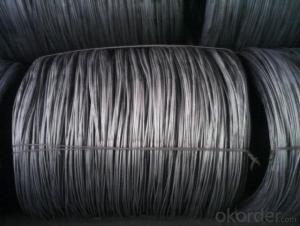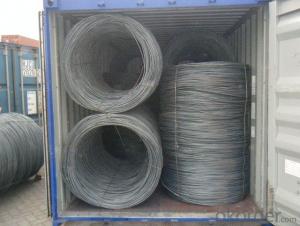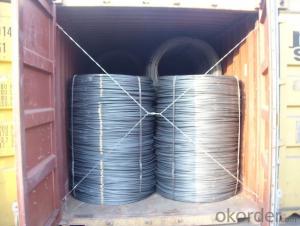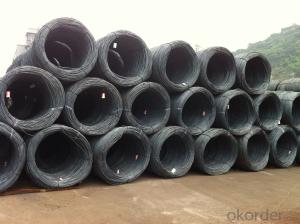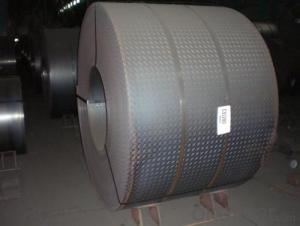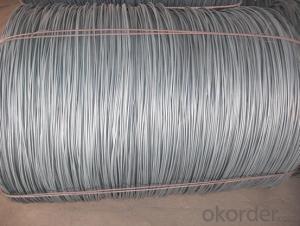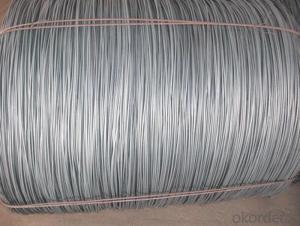Steel Wire Rod Low Carbon and Competitive Prices
- Loading Port:
- Tianjin
- Payment Terms:
- TT or LC
- Min Order Qty:
- 20 m.t.
- Supply Capability:
- 200000 m.t./month
OKorder Service Pledge
OKorder Financial Service
You Might Also Like
Product Description:
OKorder is offering Steel Wire Rod Low Carbon and Competitive Prices at great prices with worldwide shipping. Our supplier is a world-class manufacturer of steel, with our products utilized the world over. OKorder annually supplies products to European, North American and Asian markets. We provide quotations within 24 hours of receiving an inquiry and guarantee competitive prices.
Product Applications:
Steel Wire Rod Low Carbon and Competitive Prices are ideal for structural applications and are widely used in the construction of buildings and bridges, and the manufacturing, petrochemical, and transportation industries.
Product Advantages:
OKorder's Steel Wire Rod Low Carbon and Competitive Prices are durable, strong, and resist corrosion.
Main Product Features:
· Premium quality
· Prompt delivery & seaworthy packing (30 days after receiving deposit)
· Corrosion resistance
· Can be recycled and reused
· Mill test certification
· Professional Service
· Competitive pricing
Packaging & Delivery:
Packaging Detail: products are packed in bundle and then shipped by container or bulk vessel, deformed bar is usually naked strapping delivery, when storing, please pay attention to moisture proof. The performance of rust will produce adverse effect.
Each bundle weight: 2-3MT, or as required
Payment term: TT or L/C
Delivery Detail: within 45 days after received advanced payment or LC.
Label: to be specified by customer, generally, each bundle has 1-2 labels
Trade terms: FOB, CFR, CIF
FAQ:
Q1: Why buy Materials & Equipment from OKorder.com?
A1: All products offered byOKorder.com are carefully selected from China's most reliable manufacturing enterprises. Through its ISO certifications, OKorder.com adheres to the highest standards and a commitment to supply chain safety and customer satisfaction.
Q2: How do we guarantee the quality of our products?
A2: We have established an advanced quality management system which conducts strict quality tests at every step, from raw materials to the final product. At the same time, we provide extensive follow-up service assurances as required.
Q3: How soon can we receive the product after purchase?
A3: Within three days of placing an order, we will begin production. The specific shipping date is dependent upon international and government factors, but is typically 7 to 10 workdays.
Images:
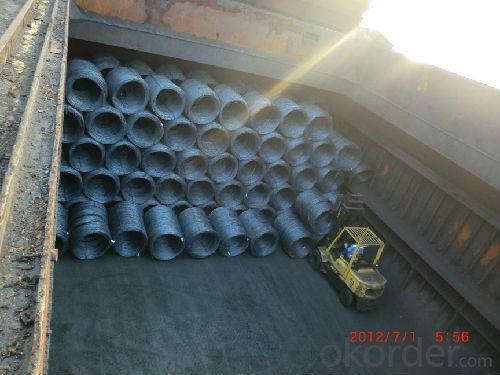
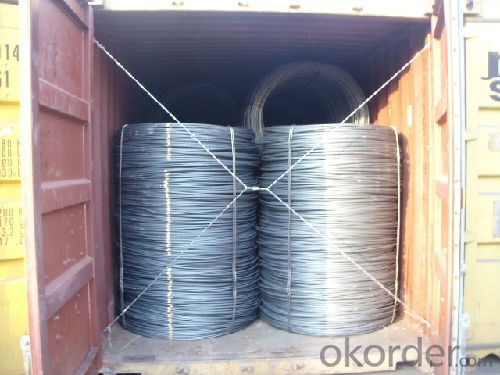
- Q:What are the major challenges faced by the steel wire rod industry?
- The steel wire rod industry faces several major challenges in today's market. One of the significant challenges is the fluctuation in raw material prices, particularly that of iron ore and coal. The steel wire rod production heavily relies on these inputs, and any significant price increase can impact the overall cost of production. Another challenge is the intense global competition. Steel wire rod manufacturers face competition from both domestic and international players. This competition puts pressure on manufacturers to constantly improve their production efficiency, reduce costs, and enhance product quality to stay competitive. Furthermore, environmental regulations and sustainability concerns pose a challenge to the industry. Steel wire rod production involves energy-intensive processes, which can lead to high carbon emissions. As governments and consumers increasingly prioritize sustainability, steel wire rod manufacturers need to invest in cleaner technologies and adopt eco-friendly practices to reduce their carbon footprint. Moreover, the fluctuating demand for steel wire rods can be a challenge for the industry. Steel wire rods are used in various sectors such as construction, automotive, and manufacturing. The demand for these sectors is subject to economic cycles and external factors such as government policies, infrastructure projects, and consumer spending. Therefore, manufacturers need to closely monitor market trends and adjust their production accordingly to avoid overproduction or underutilization of capacity. Additionally, the industry faces the challenge of technological advancements. With the rise of automation and digitalization, steel wire rod manufacturers need to invest in advanced technologies to improve production efficiency, reduce downtime, and enhance product quality. This requires significant capital investment and skilled labor, which can be a challenge for some companies. Lastly, the industry needs to address the issue of counterfeit products. Counterfeit steel wire rods can pose significant safety risks to end-users. Manufacturers need to implement strict quality control measures and work closely with regulatory authorities to prevent the circulation of counterfeit products in the market. In conclusion, the steel wire rod industry faces challenges such as fluctuating raw material prices, intense global competition, environmental regulations, fluctuating demand, technological advancements, and the issue of counterfeit products. Overcoming these challenges requires continuous innovation, strategic planning, and a focus on sustainability to ensure the long-term success of the industry.
- Q:What are the common applications of oil quenched and tempered steel wire rod?
- Oil quenched and tempered steel wire rod possesses unique properties that make it suitable for a diverse range of industries. Its applications include: 1. Automotive Industry: The automotive industry extensively utilizes oil quenched and tempered steel wire rod to manufacture various components, including suspension springs, engine valve springs, clutch springs, and transmission gears. The material's high strength and excellent fatigue resistance make it ideal for these demanding applications. 2. Construction Industry: In the construction industry, this type of steel wire rod is widely employed to produce high-strength wire ropes, prestressed concrete wires, and reinforcement bars. Its exceptional strength and durability enable it to withstand heavy loads and extreme conditions in construction projects. 3. Manufacturing Industry: Within the manufacturing sector, this steel wire rod is utilized to produce high-strength fasteners like bolts, nuts, and screws that require resistance to deformation. It is also used in the manufacturing of machinery components, such as gears, shafts, and springs, where toughness and wear resistance are crucial. 4. Oil and Gas Industry: The oil and gas industry extensively relies on oil quenched and tempered steel wire rod for applications like wireline cables, well drilling components, and downhole equipment. The material's high tensile strength and corrosion resistance enable it to endure the harsh conditions encountered in oil and gas exploration and production. 5. Aerospace Industry: The aerospace industry employs this steel wire rod in the production of aircraft cables, landing gear components, and structural parts. Its combination of high strength, fatigue resistance, and light weight make it an ideal choice for these critical applications. In summary, oil quenched and tempered steel wire rod is a versatile material that demonstrates exceptional strength, durability, and resistance to deformation. As a result, it finds applications across a wide range of industries.
- Q:How is steel wire rod used in the production of wire for springs in furniture?
- Steel wire rod is used in the production of wire for springs in furniture as it serves as the raw material for manufacturing the wire. The wire rod is drawn and coated to create the desired thickness and strength required for the springs. This wire is then further processed and coiled to form the springs that provide support and resilience in furniture, ensuring comfort and durability.
- Q:How is steel wire rod used in the production of wire baskets?
- Steel wire rod is used in the production of wire baskets as it serves as the primary material for creating the basket's structure. The wire rod is first shaped and welded to form the basket's frame, providing the necessary strength and durability. Additionally, the steel wire rod can be further processed to create the mesh or grid pattern that forms the sides and base of the basket, allowing for the containment and organization of various items.
- Q:What are the major innovations in steel wire rod production technology?
- There have been several major innovations in steel wire rod production technology in recent years. These advancements have greatly improved the efficiency, quality, and sustainability of the production process. One major innovation is the implementation of continuous casting technology. Traditionally, steel wire rods were produced through a batch process, where molten steel was poured into individual molds and allowed to solidify before being cut into rods. Continuous casting, on the other hand, allows for a continuous flow of molten steel to be solidified into long strands. This not only eliminates the need for individual molds but also increases the speed and productivity of the production process. Another significant innovation is the use of high-speed rolling mills. These mills are equipped with advanced technologies that allow for faster rolling speeds and higher production rates. The use of high-speed rolling mills not only increases the output of steel wire rods but also improves the quality and consistency of the final product. Furthermore, the development of automation and digital technologies has revolutionized steel wire rod production. Automated systems and robotics are now being used to control various stages of the production process, from the handling of raw materials to the packaging of finished products. This not only reduces the risk of human error but also enhances overall efficiency and productivity. Additionally, there have been advancements in the field of metallurgy, leading to the production of stronger and more durable steel wire rods. Through the use of advanced alloys and heat treatment processes, manufacturers can now produce rods with superior mechanical properties, such as higher tensile strength and improved resistance to corrosion and fatigue. Lastly, there has been a growing focus on sustainability in steel wire rod production. Innovations in energy-efficient technologies and waste reduction strategies have led to significant improvements in the environmental impact of the industry. For example, the implementation of energy recovery systems and the use of recycled materials in the production process have helped reduce energy consumption and minimize waste generation. In conclusion, the major innovations in steel wire rod production technology include the implementation of continuous casting, the use of high-speed rolling mills, the integration of automation and digital technologies, advancements in metallurgy, and a growing emphasis on sustainability. These innovations have not only improved the efficiency and quality of steel wire rod production but have also contributed to a more sustainable and environmentally friendly industry.
- Q:What are the different types of steel wire rod surface cleaning methods for wire galvanizing?
- Wire galvanizing requires the use of various steel wire rod surface cleaning methods to eliminate impurities and contaminants. These methods are specifically designed to prepare the wire rod for the galvanizing process. One commonly used technique is acid pickling, which involves immersing the wire rod in a bath containing hydrochloric acid or sulfuric acid. The acid effectively dissolves mill scale, rust, and other contaminants, leaving the wire rod clean and ready for galvanizing. Another method, mechanical descaling, employs mechanical means such as abrasive brushes or shot blasting to physically eliminate surface impurities. This method is ideal for wire rods with heavy scale or stubborn contaminants that cannot be easily removed through acid pickling alone. Additionally, there is the electrolytic cleaning method, which utilizes an electric current to eliminate surface impurities. The wire rod is submerged in an electrolyte solution, and the electric current causes the impurities to migrate away from the wire rod towards the opposite electrode. This method is typically employed for wire rods with a thin layer of oxide or other surface contaminants. Lastly, mechanical cleaning involves using mechanical means like wire brushing or sanding to scrub the wire rod's surface and eliminate any impurities. This method is suitable for wire rods with light scale or surface contaminants that can be easily removed through mechanical means. Ultimately, the selection of a cleaning method depends on the specific requirements and condition of the wire rod. Each method has its own advantages and disadvantages in terms of effectiveness, cost, and environmental impact.
- Q:What are the main factors affecting the market growth of steel wire rod?
- The main factors affecting the market growth of steel wire rod include demand from various industries such as construction, automotive, and manufacturing. Economic growth and infrastructure development also play a significant role. Additionally, raw material availability, technological advancements, and government policies related to trade and investment can impact the market growth of steel wire rod.
- Q:How is steel wire rod used in the production of wire ropes for marine applications?
- Steel wire rod is used in the production of wire ropes for marine applications as it serves as the raw material for manufacturing the individual wires that are twisted together to form the rope. The steel wire rod undergoes a series of processes including drawing, heat treatment, and galvanizing to enhance its strength, flexibility, and corrosion resistance. These wire ropes are then utilized in various marine applications such as ship mooring, lifting heavy loads, and securing offshore structures due to their high tensile strength and durability in harsh marine environments.
- Q:What are the typical dimensions of steel wire rod?
- The typical dimensions of steel wire rod vary depending on the specific application and industry requirements. However, common dimensions range from 5.5mm to 14mm in diameter.
- Q:What are the main factors affecting the market competition of steel wire rod?
- The main factors affecting the market competition of steel wire rod include the demand and supply dynamics, pricing strategies of competitors, technological advancements, government regulations, availability of raw materials, and the overall economic conditions. Additionally, factors like product quality, customer preferences, and brand reputation also play a significant role in determining the level of competition within the steel wire rod market.
1. Manufacturer Overview |
|
|---|---|
| Location | |
| Year Established | |
| Annual Output Value | |
| Main Markets | |
| Company Certifications | |
2. Manufacturer Certificates |
|
|---|---|
| a) Certification Name | |
| Range | |
| Reference | |
| Validity Period | |
3. Manufacturer Capability |
|
|---|---|
| a)Trade Capacity | |
| Nearest Port | |
| Export Percentage | |
| No.of Employees in Trade Department | |
| Language Spoken: | |
| b)Factory Information | |
| Factory Size: | |
| No. of Production Lines | |
| Contract Manufacturing | |
| Product Price Range | |
Send your message to us
Steel Wire Rod Low Carbon and Competitive Prices
- Loading Port:
- Tianjin
- Payment Terms:
- TT or LC
- Min Order Qty:
- 20 m.t.
- Supply Capability:
- 200000 m.t./month
OKorder Service Pledge
OKorder Financial Service
Similar products
New products
Hot products
Hot Searches
Related keywords
